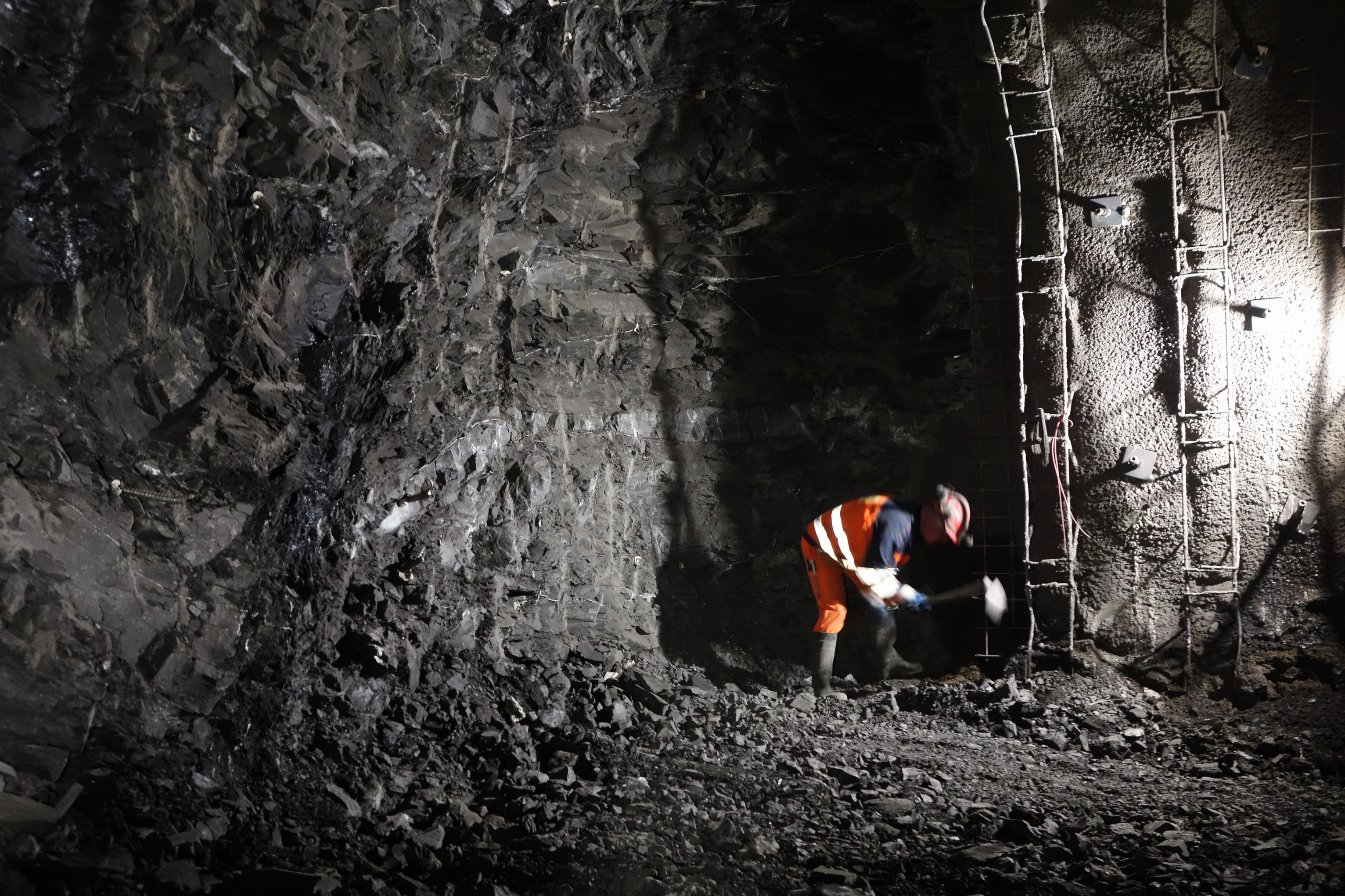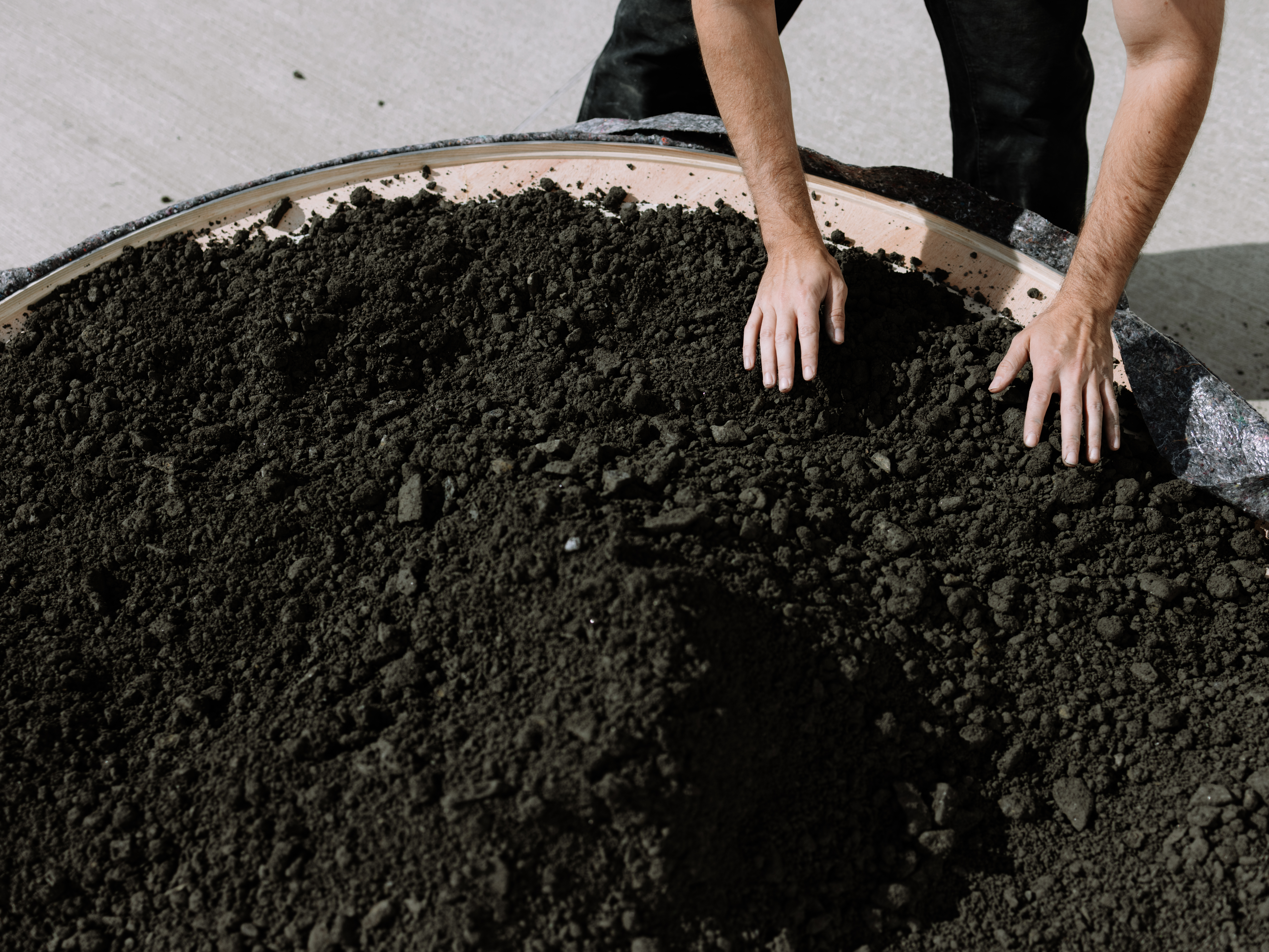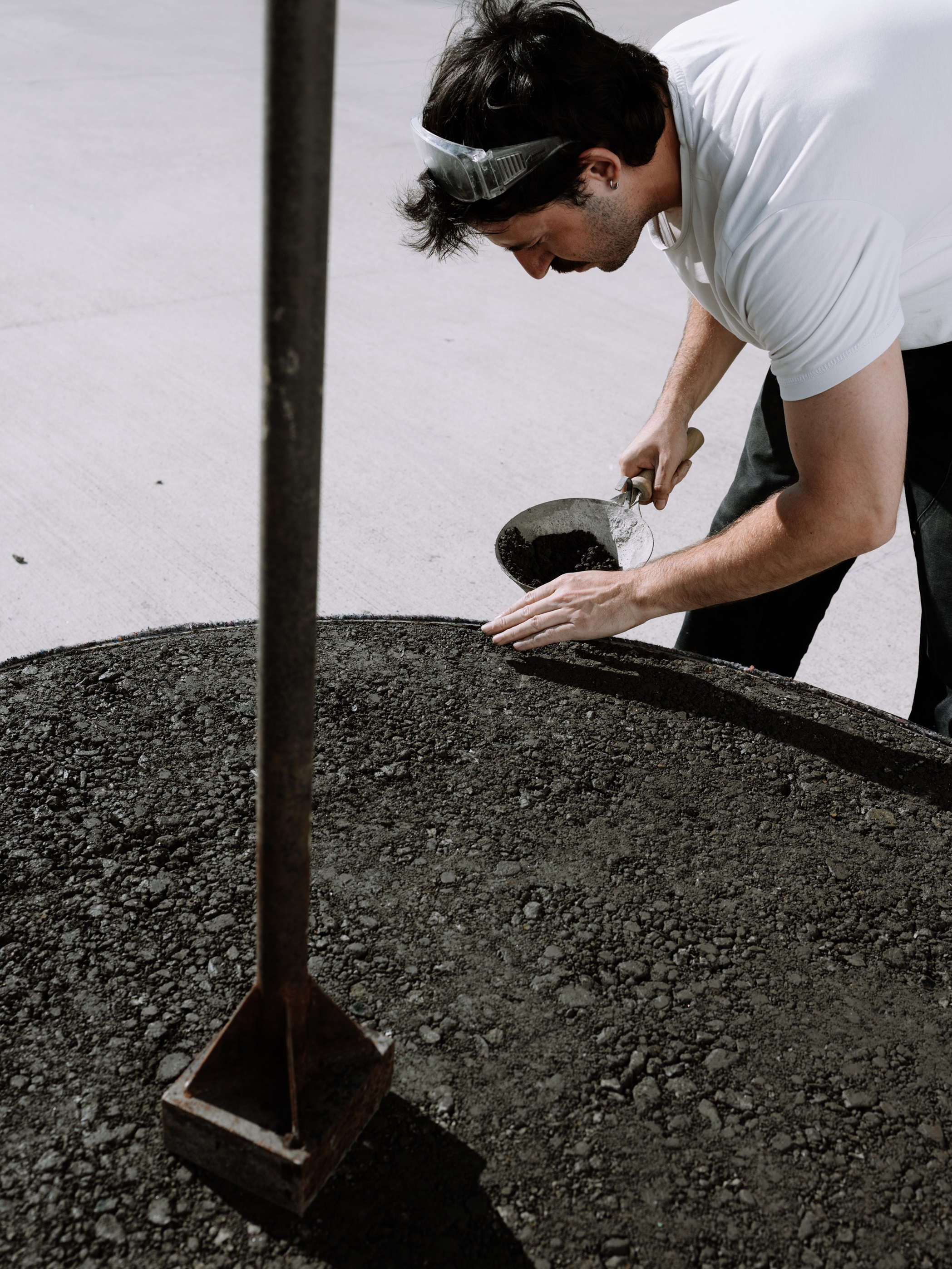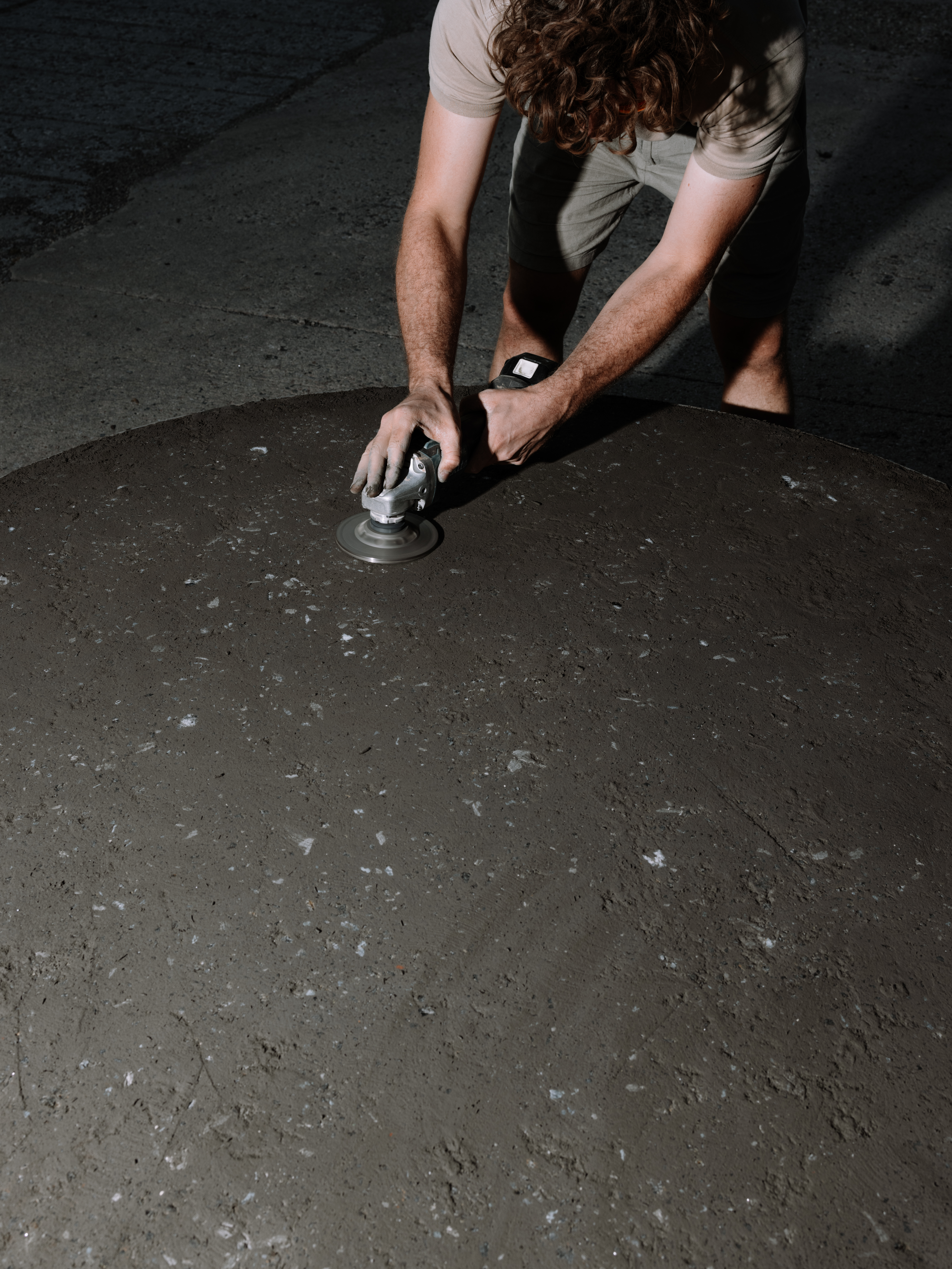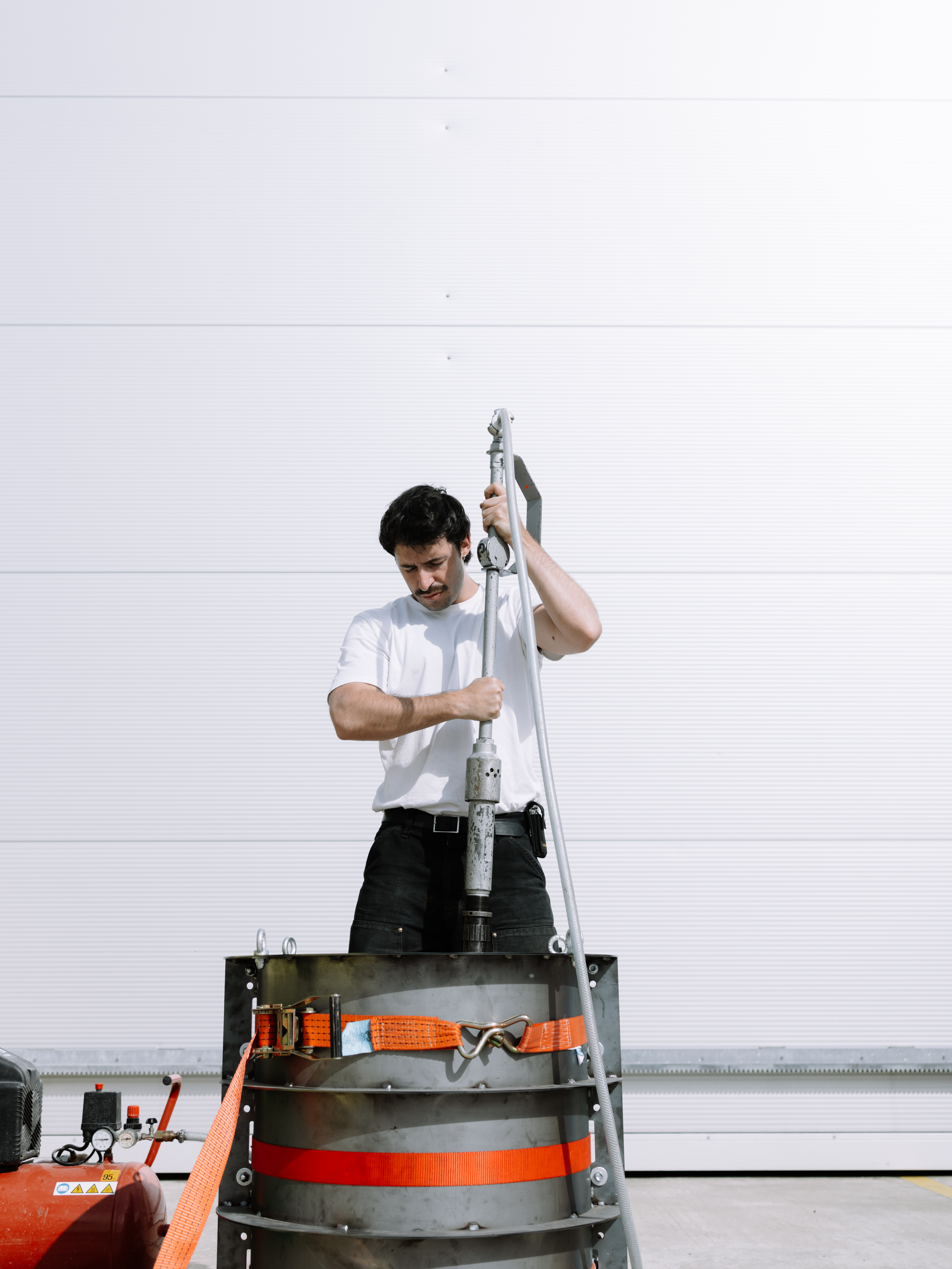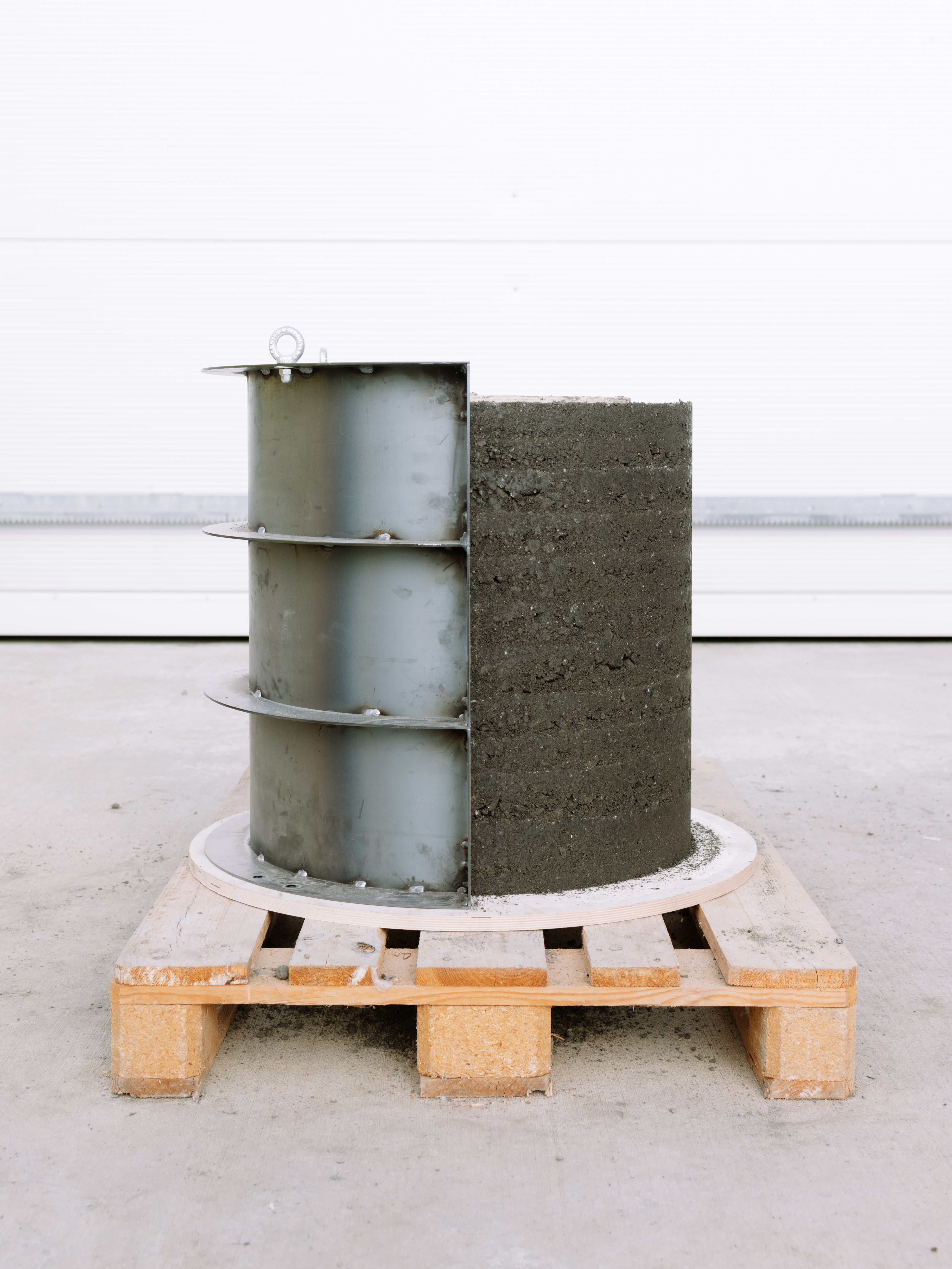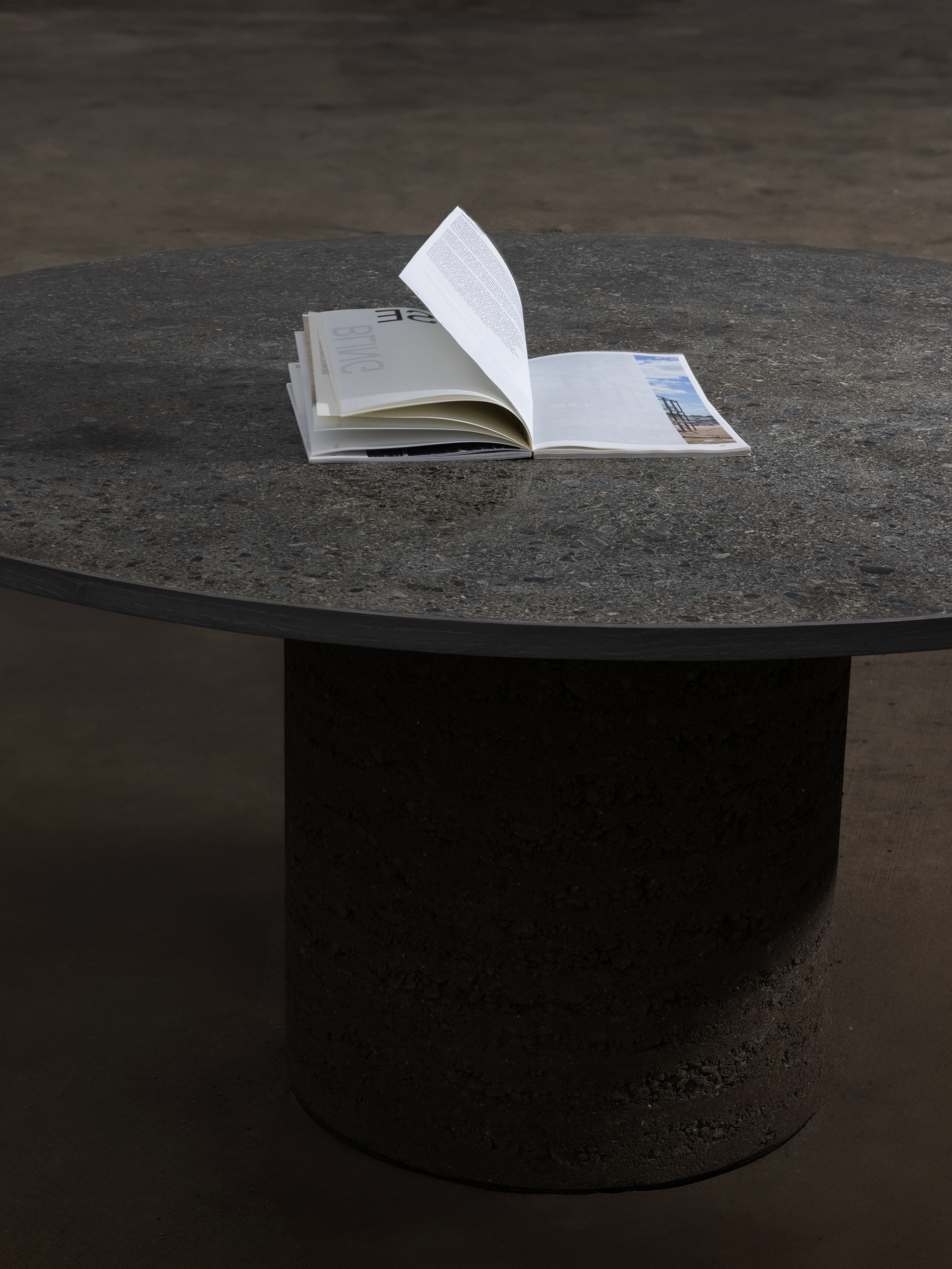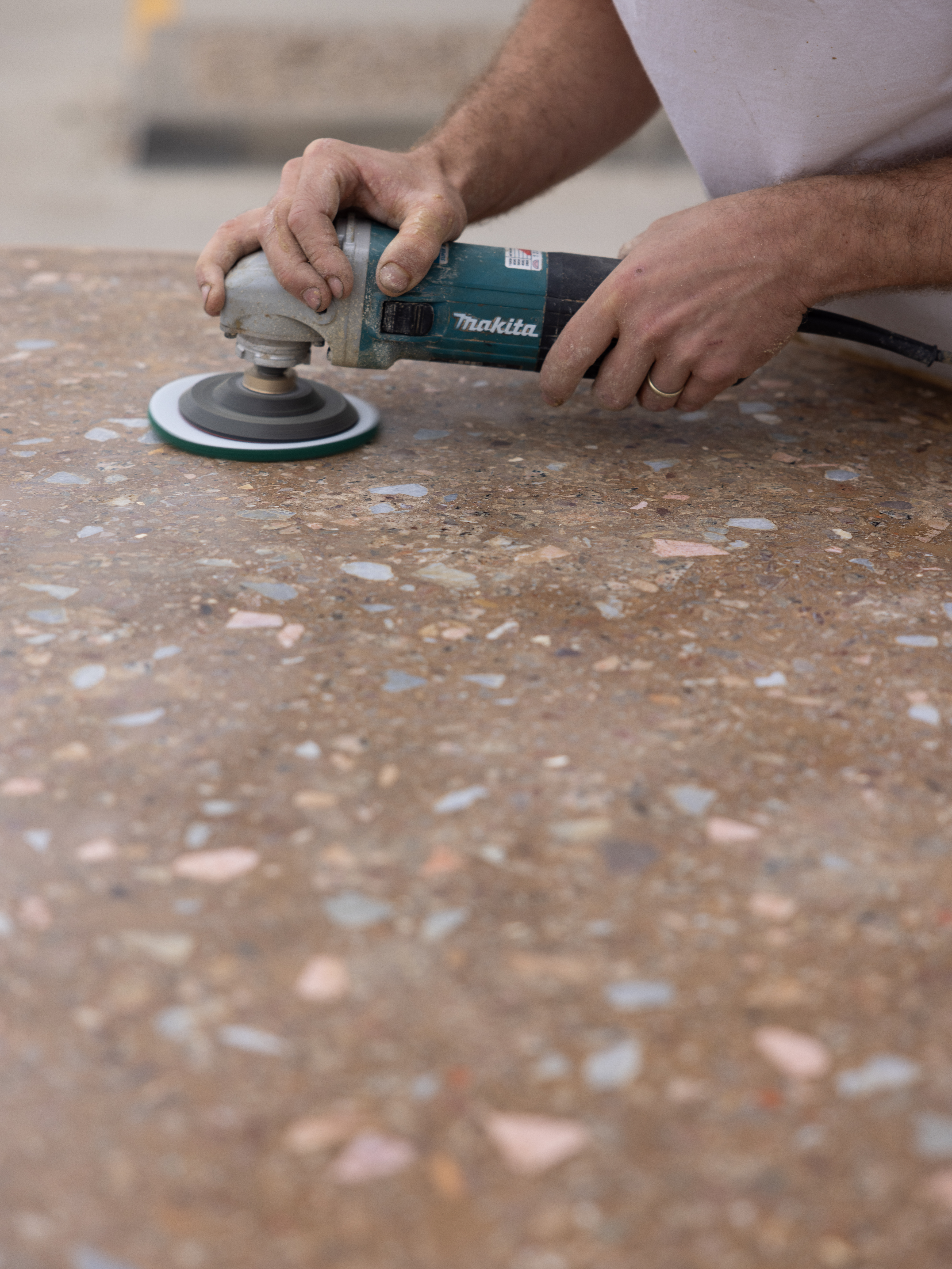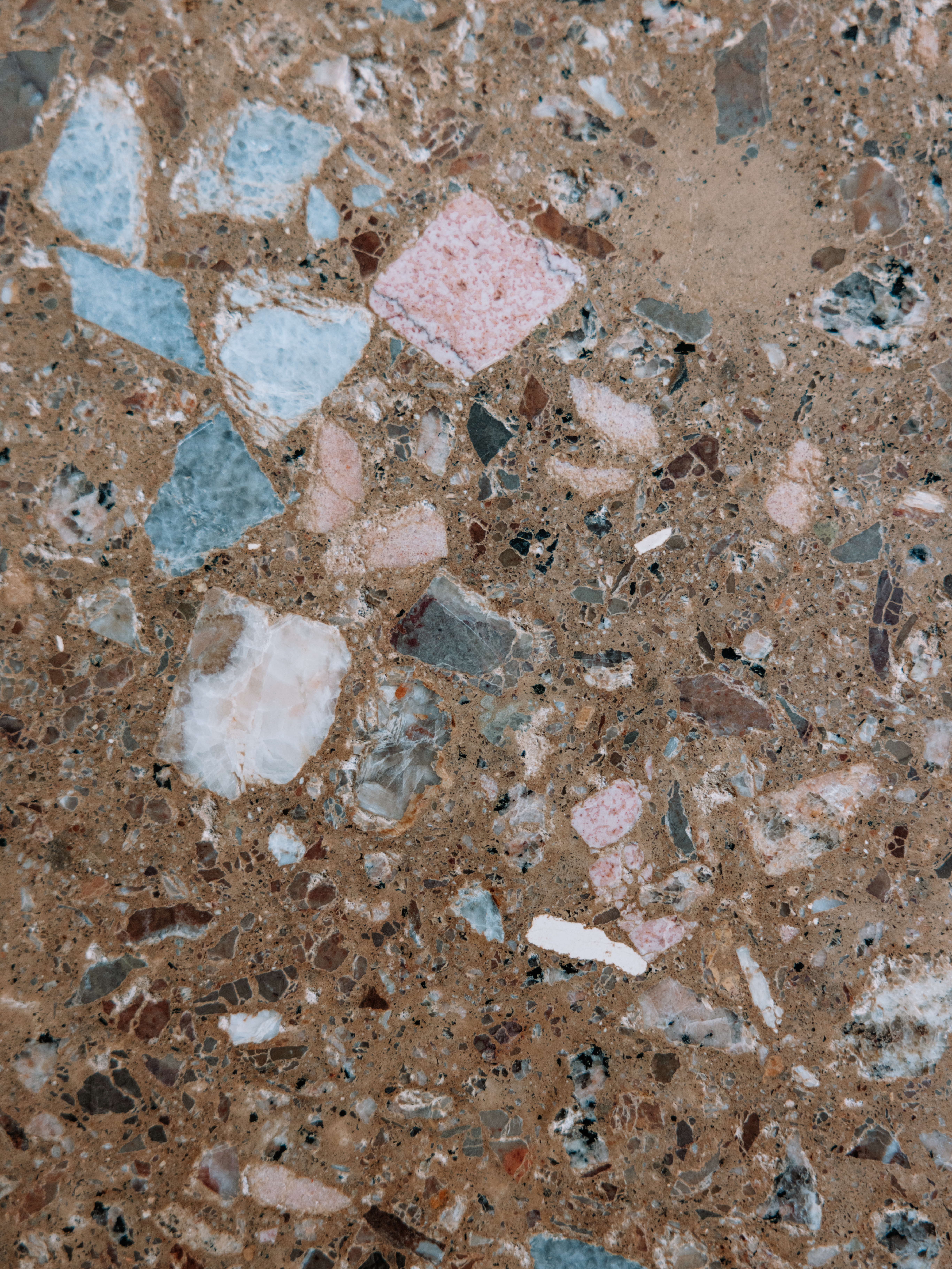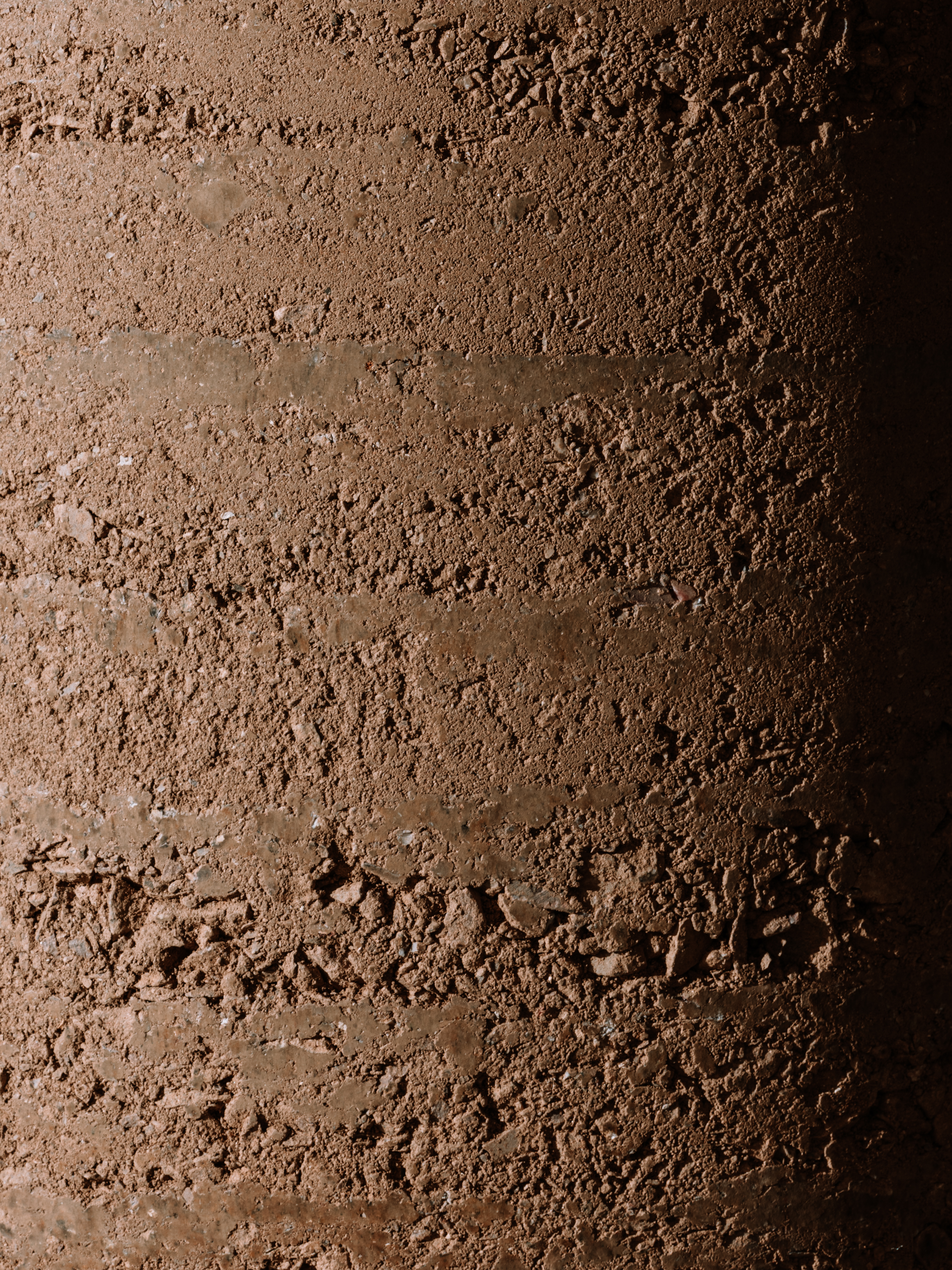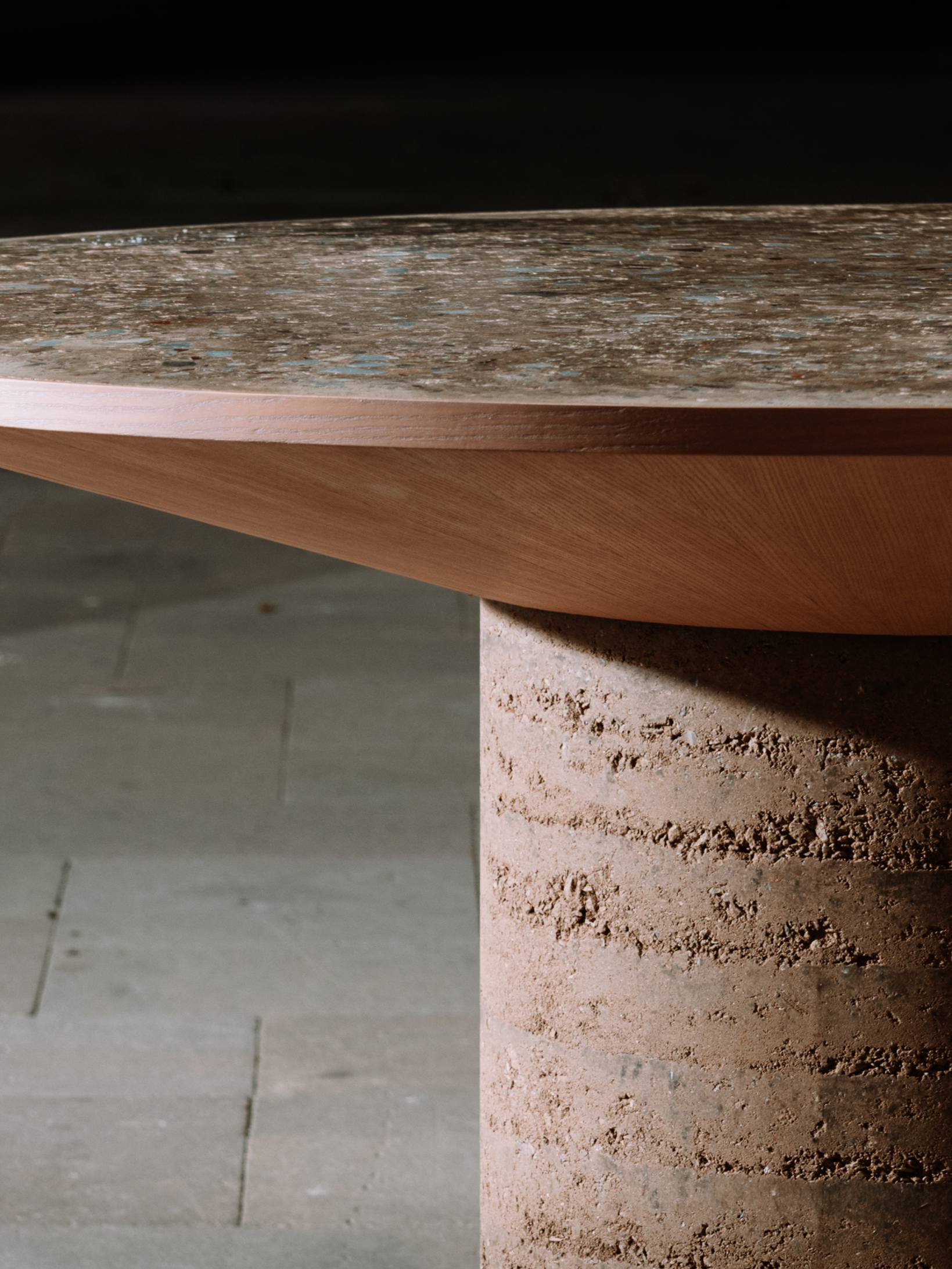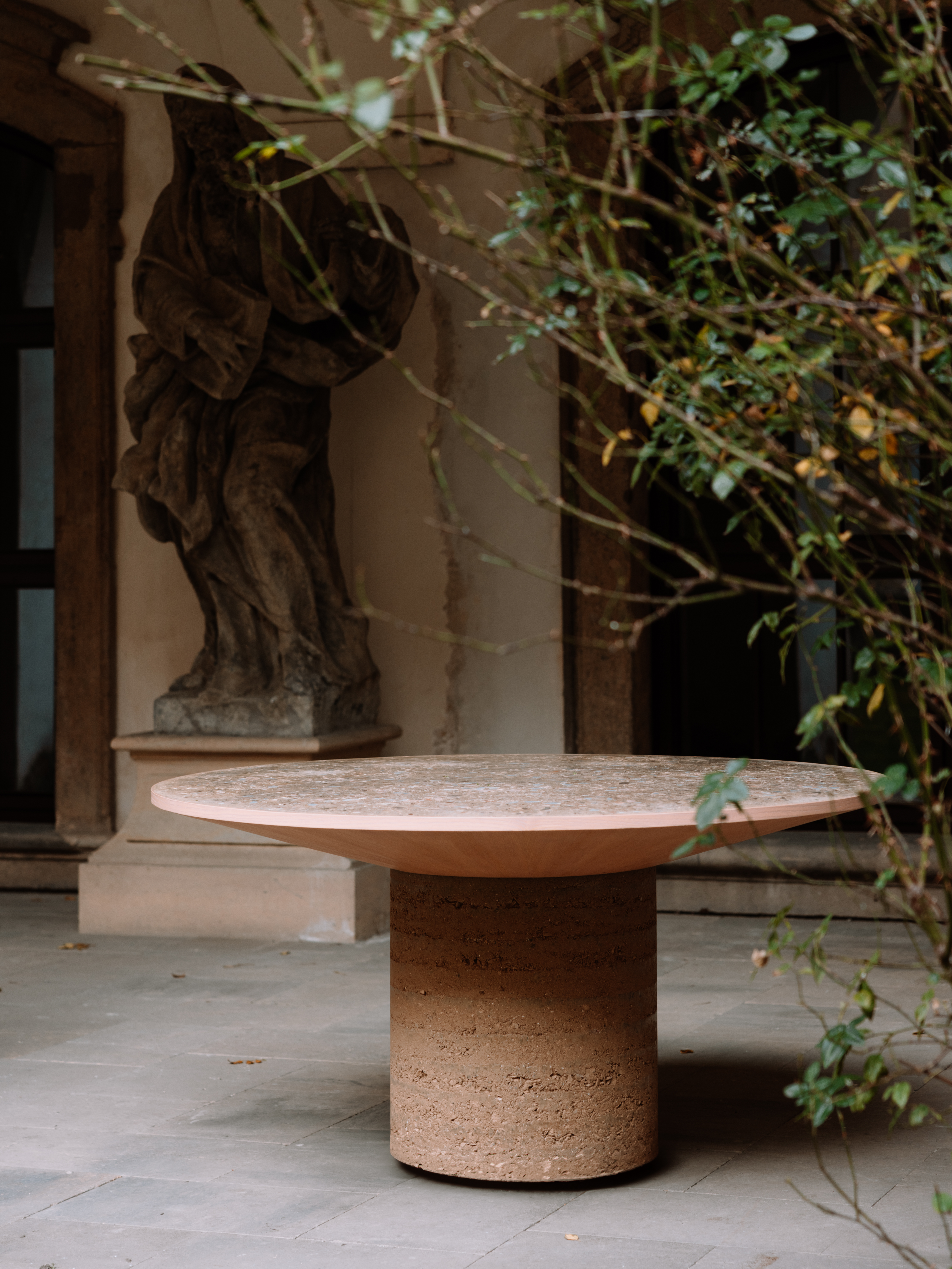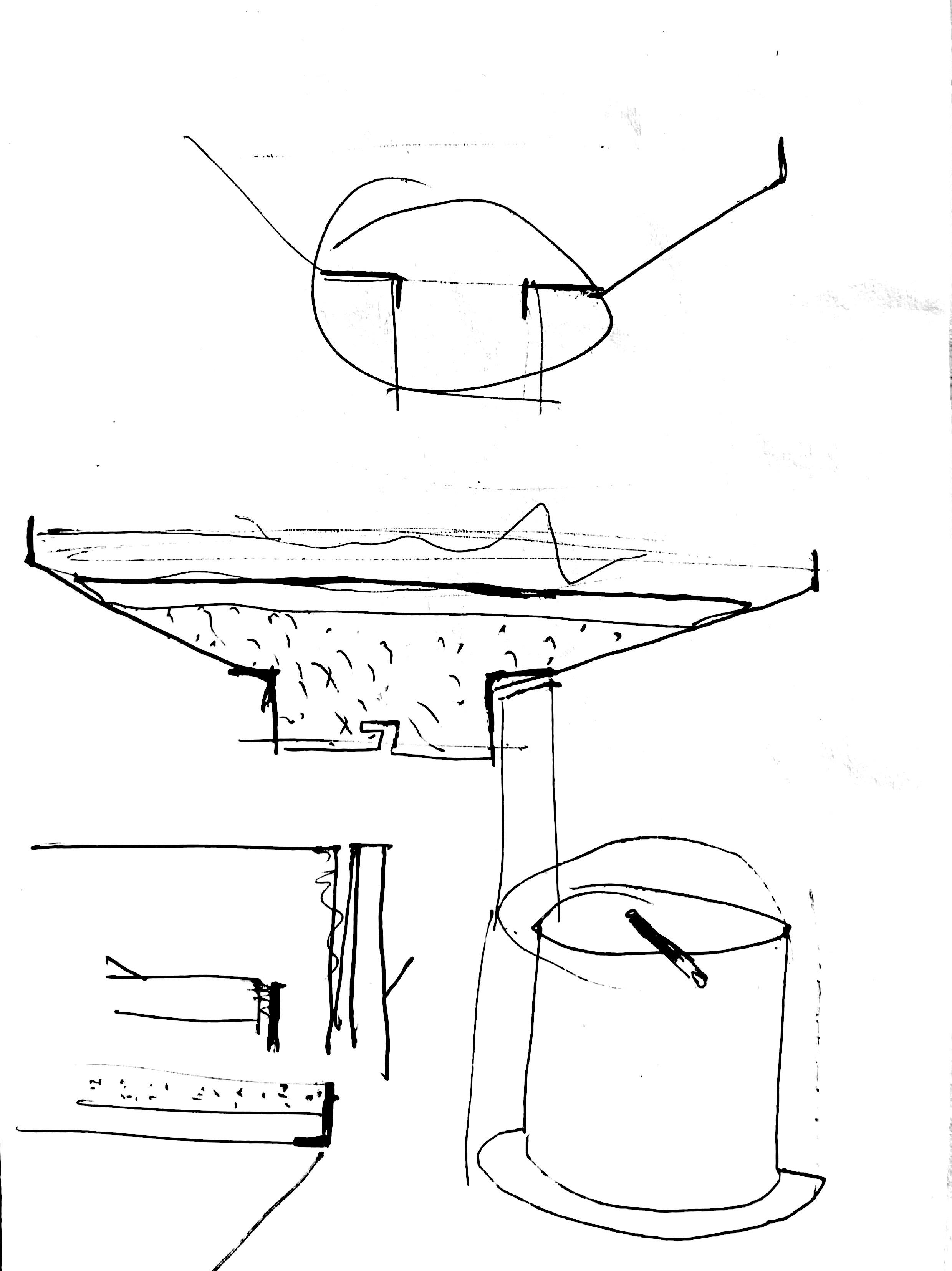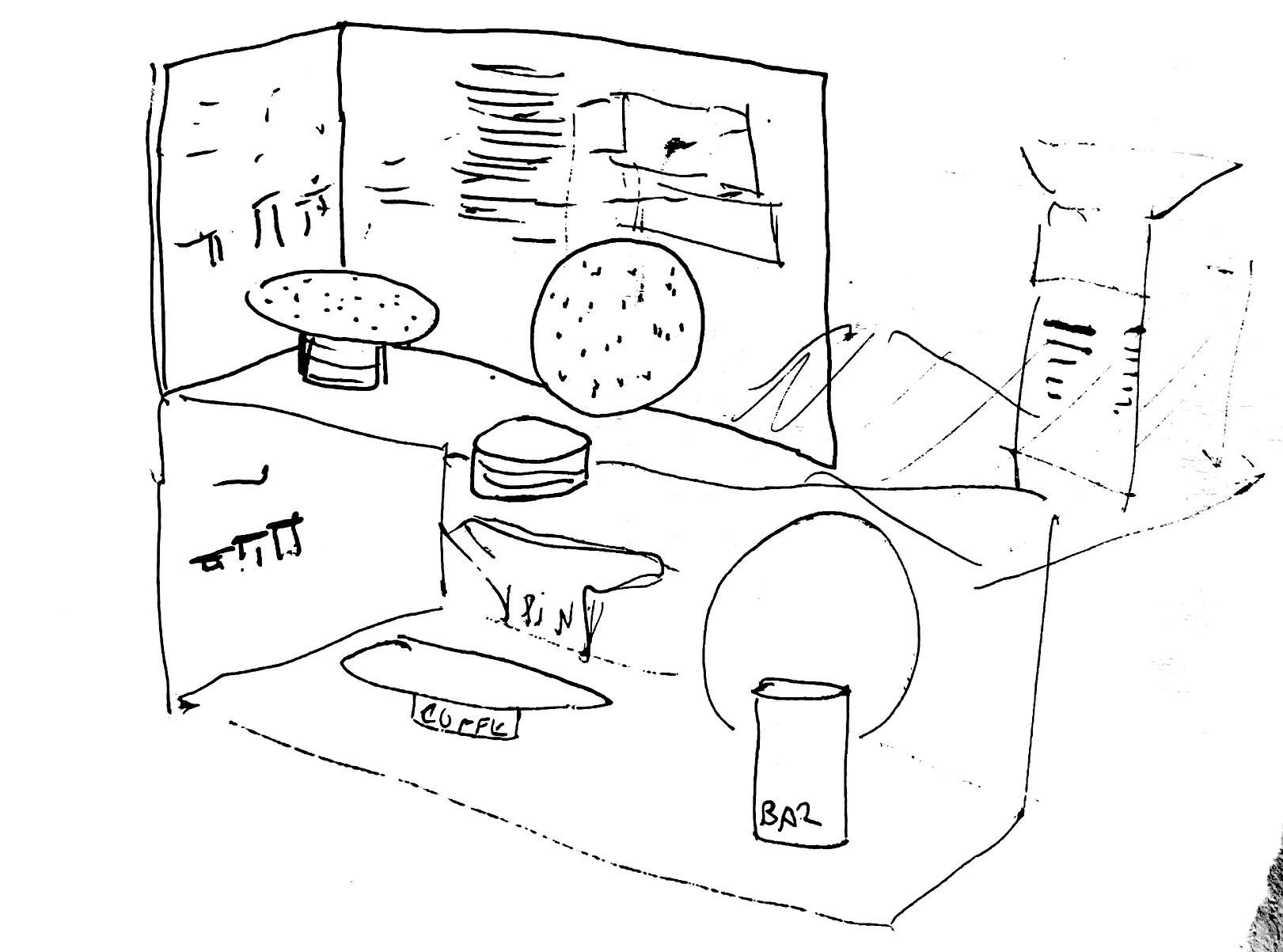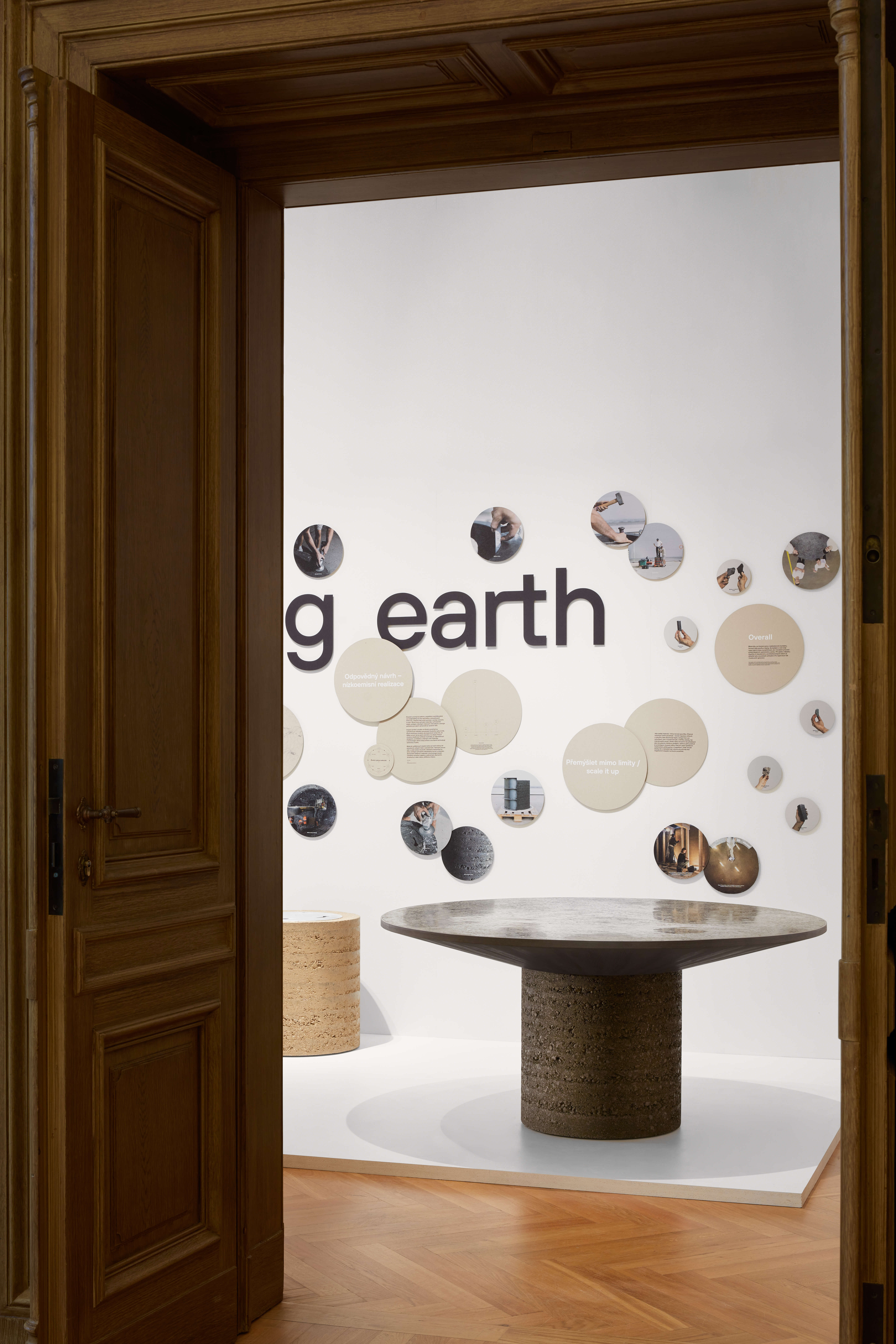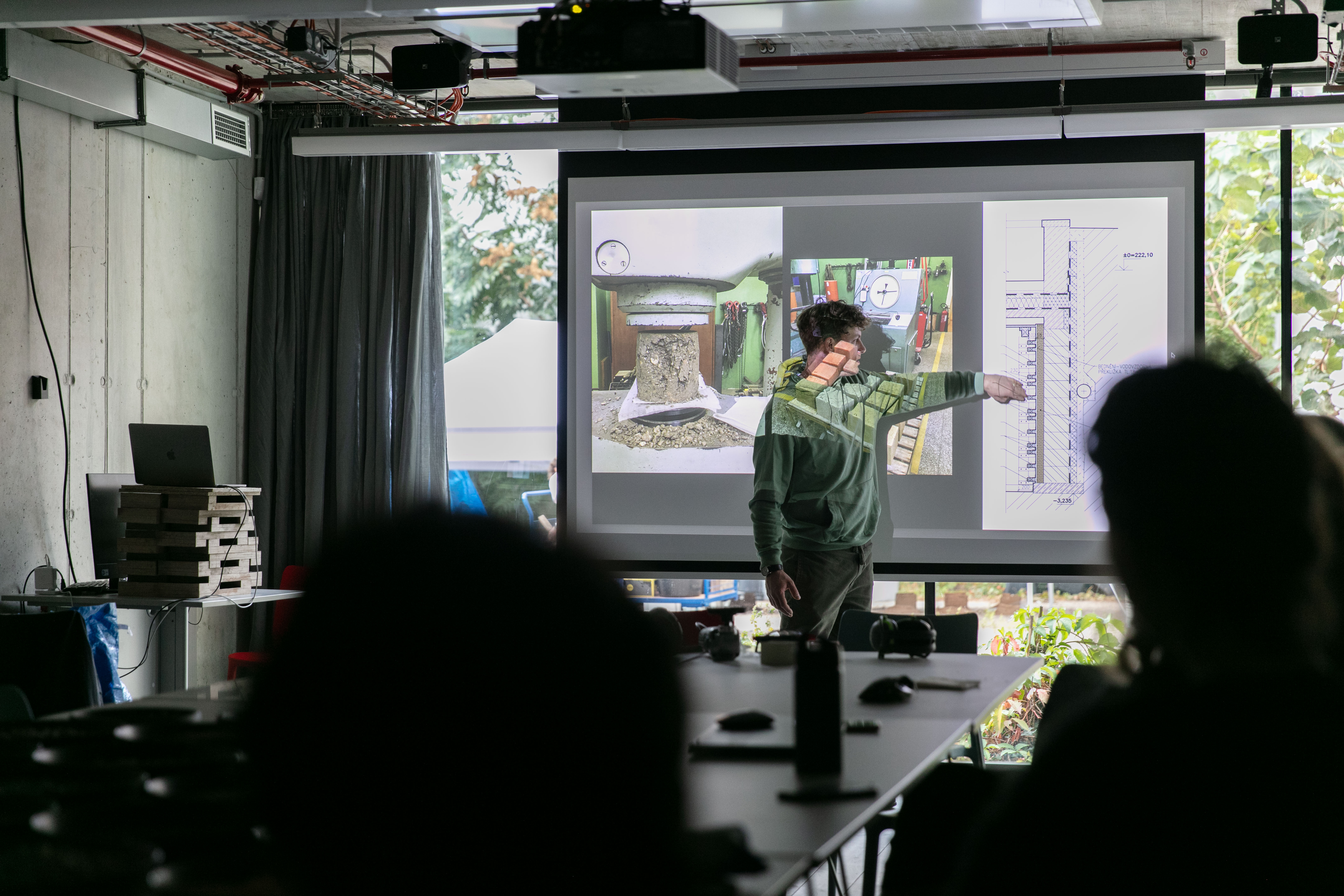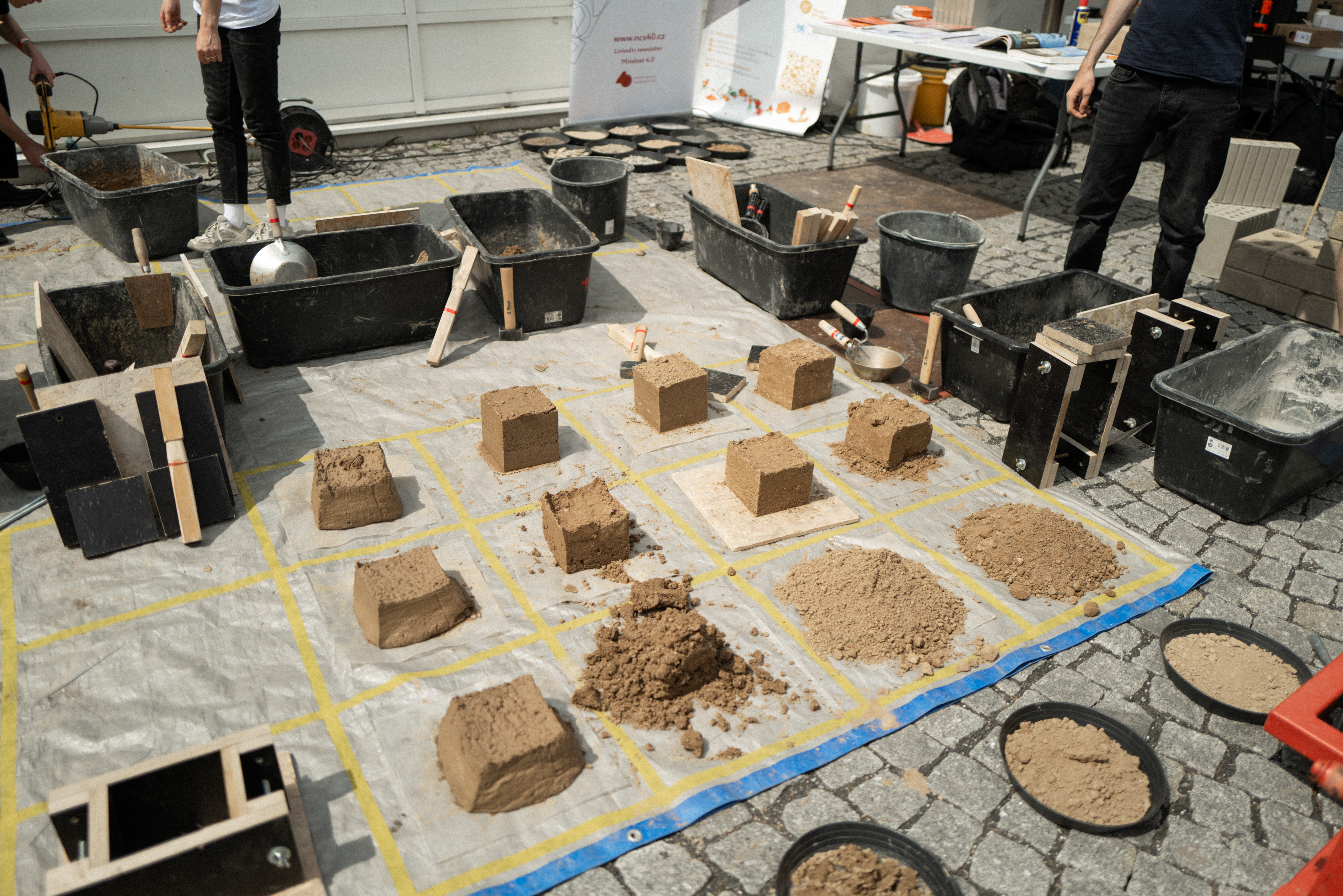Shaping a circular industrial ecosystem and supporting life-cycle thinking
young earth
Using tunnel excavations from the new metro line in Prague for sustainable design and architecture.
Kolemhlíny platform, in collaboration with the Studio JanskyDundera, offers a fresh perspective from a young group of professionals on utilizing local waste earth through the monumental around table. Two handcrafted models were created from stonemasonry scraps and rock excavated during the construction of Prague's new Metro D line.
Czechia
Local
Prague
It addresses urban-rural linkages
It refers to a physical transformation of the built environment (hard investment)
Yes
2024-10-02
No
No
No
As an individual partnership with other persons/organisation(s)
Overall Aim
Our project introduces the use of rammed earth in design and architecture to the Czech audience, highlighting its sustainability, aesthetic quality, and unique physical properties. It aims to challenge widespread misconceptions about earth as a material perceived as outdated, aesthetically inferior, or structurally weak. These myths stem from historical use before modern technical solutions, such as proper waterproofing and insulation, were developed. By demonstrating its contemporary potential, we respond to pressing environmental challenges, including climate change and the growing demand for sustainable materials.
Target Group
The project targets both the professional community - architects, engineers, designers, and artists - and the general public, who will engage with earthen materials as end-users. Bridging these audiences fosters a cultural shift in material perception, paving the way for informed decision-making in construction and design.
Specific objective(s)
Showcase the potential of excavated earth waste through a tangible, functional object - around table - crafted from rammed earth and upcycled stone offcuts. The table represents large-format samples of polished rammed earth flooring and a rammed earth wall, demonstrating their direct applicability in contemporary architecture and interior design.
Utilize mainly local materials sourced within an 11 km radius of Prague’s city center, minimizing transportation emissions and emphasizing material circularity.
Incorporate stone remnants with cultural significance, such as marble used for Prague Castle’s Bull Staircase or in the city’s historical pavement mosaics, reinforcing the dialogue between sustainability and local heritage.
Develop two versions of the table: a light variant using residual earth from residential construction and a dark one incorporating excavated slate from Prague’s new Metro D line - material currently considered waste despite its vast availability.
Our project introduces the use of rammed earth in design and architecture to the Czech audience, highlighting its sustainability, aesthetic quality, and unique physical properties. It aims to challenge widespread misconceptions about earth as a material perceived as outdated, aesthetically inferior, or structurally weak. These myths stem from historical use before modern technical solutions, such as proper waterproofing and insulation, were developed. By demonstrating its contemporary potential, we respond to pressing environmental challenges, including climate change and the growing demand for sustainable materials.
Target Group
The project targets both the professional community - architects, engineers, designers, and artists - and the general public, who will engage with earthen materials as end-users. Bridging these audiences fosters a cultural shift in material perception, paving the way for informed decision-making in construction and design.
Specific objective(s)
Showcase the potential of excavated earth waste through a tangible, functional object - around table - crafted from rammed earth and upcycled stone offcuts. The table represents large-format samples of polished rammed earth flooring and a rammed earth wall, demonstrating their direct applicability in contemporary architecture and interior design.
Utilize mainly local materials sourced within an 11 km radius of Prague’s city center, minimizing transportation emissions and emphasizing material circularity.
Incorporate stone remnants with cultural significance, such as marble used for Prague Castle’s Bull Staircase or in the city’s historical pavement mosaics, reinforcing the dialogue between sustainability and local heritage.
Develop two versions of the table: a light variant using residual earth from residential construction and a dark one incorporating excavated slate from Prague’s new Metro D line - material currently considered waste despite its vast availability.
Local resources
Waste upcycling
Circularity
Rammed earth
Community engagement
Our project embodies the principles of the New European Bauhaus by integrating sustainability, inclusivity, and aesthetic qualities in the use of local, natural materials. It prioritizes locally sourced waste materials, including stone offcuts and excavated earth from construction sites, eliminating the need for high-emission stabilizers. The rammed earth mixture remains fully reusable and retains its natural properties, such as moisture regulation. By using resources available within an 11 km radius of Prague, the project minimizes transport emissions and promotes a circular approach to material use.
A key aspect of the project is its aesthetic quality, achieved through collaboration with the Prague-based design studio JanskyDundera, ensuring a timeless and functional design. It challenges the perception of earth as a "poor" material by showcasing its refined texture, unique haptic qualities, and structural integrity. The project demonstrates that sustainability and beauty are not mutually exclusive but can complement each other in contemporary design.
Beyond material innovation, the project actively fosters inclusivity and knowledge-sharing. Guided tours and educational lectures explain its environmental and cultural significance, helping to build a network of like-minded individuals and organizations that support sustainable design and construction. Workshops and lectures introduce architects, engineers, and designers to the potential of rammed earth, equipping them with the knowledge to incorporate it into their future projects.
By combining thoughtful material choices, design, and public engagement, the project serves as a replicable model for integrating circular principles into contemporary architecture and design.
A key aspect of the project is its aesthetic quality, achieved through collaboration with the Prague-based design studio JanskyDundera, ensuring a timeless and functional design. It challenges the perception of earth as a "poor" material by showcasing its refined texture, unique haptic qualities, and structural integrity. The project demonstrates that sustainability and beauty are not mutually exclusive but can complement each other in contemporary design.
Beyond material innovation, the project actively fosters inclusivity and knowledge-sharing. Guided tours and educational lectures explain its environmental and cultural significance, helping to build a network of like-minded individuals and organizations that support sustainable design and construction. Workshops and lectures introduce architects, engineers, and designers to the potential of rammed earth, equipping them with the knowledge to incorporate it into their future projects.
By combining thoughtful material choices, design, and public engagement, the project serves as a replicable model for integrating circular principles into contemporary architecture and design.
The project focuses on creating a unique, timeless design that combines sustainability with aesthetic appeal. Collaborating with the Prague-based design studio JanskyDundera, we crafted a table that not only highlights the beauty of locally sourced, repurposed materials but also provides a high-quality tactile experience for users. The use of rammed earth and stone offcuts gives the table a distinctive, refined texture that connects it to Prague’s cultural heritage, offering both visual and emotional value.
This project aims to transform public perceptions of earth as a material, showing that it can be both aesthetic and functional. By reusing materials often viewed as waste, it encourages more thoughtful consumption and sparks conversations about the value of repurposing materials in design. Ultimately, it demonstrates that sustainable design can offer both cultural richness and tangible value, influencing how people experience and engage with materials in their surroundings.
This project aims to transform public perceptions of earth as a material, showing that it can be both aesthetic and functional. By reusing materials often viewed as waste, it encourages more thoughtful consumption and sparks conversations about the value of repurposing materials in design. Ultimately, it demonstrates that sustainable design can offer both cultural richness and tangible value, influencing how people experience and engage with materials in their surroundings.
The young earth installation and table around have sparked interest in DIY clay workshops, promoting the use of clay as an affordable, accessible local material. The project makes clay processing approachable for people of all ages and social backgrounds, from large-scale industrial use to individual, community-based creation. The kolemhlíny platform educates the public on clay types and their combinations with other materials, empowering communities through shared knowledge.
This approach fosters inclusive design, showing that sustainability can be accessible to all, not just elite circles. By engaging both local professionals and the public, the project promotes community collaboration and helps create more inclusive, sustainable societal models through hands-on education and accessible material use.
This approach fosters inclusive design, showing that sustainability can be accessible to all, not just elite circles. By engaging both local professionals and the public, the project promotes community collaboration and helps create more inclusive, sustainable societal models through hands-on education and accessible material use.
The project actively involved local professionals, such as the JanskyDundera studio, in the design and implementation process. The use of excavations from metro tunnel construction and building foundations, and waste stone remnants, often overlooked in both public discourse and by experts, was a key aspect of the project. This focus sparked interest among local construction companies and architects. Although collaboration with large-scale contractors is not documented, the project has highlighted the potential for alternative handling of excavation materials, moving beyond their typical use as landfill fill to incorporating them as viable building materials in the future.
This involvement has a potential of direct impact on the quality of life for citizens by bringing them into contact with sustainable materials in their daily environments. Additionally, through the promotion of responsible material use, the project contributes to reducing the environmental impact of construction. By showcasing the potential of waste materials to become valuable resources, the project advocates for a circular economy within the construction industry, benefiting both local communities and the environment.
This approach demonstrates how collaborative, locally-driven initiatives can inspire change in established industries and contribute to a more sustainable, inclusive future.
This involvement has a potential of direct impact on the quality of life for citizens by bringing them into contact with sustainable materials in their daily environments. Additionally, through the promotion of responsible material use, the project contributes to reducing the environmental impact of construction. By showcasing the potential of waste materials to become valuable resources, the project advocates for a circular economy within the construction industry, benefiting both local communities and the environment.
This approach demonstrates how collaborative, locally-driven initiatives can inspire change in established industries and contribute to a more sustainable, inclusive future.
The project engaged various stakeholders across different levels. Locally, JanskyDundera studio played a key role in the design and execution, contributing to the creation of a timeless product. Regional construction companies were involved by introducing the innovative use of waste excavation materials. This collaboration sparked interest in utilizing these materials beyond landfill, encouraging a shift in local construction practices.
Nationally, the project drew attention to sustainable design practices, promoting the reuse of waste materials in construction, particularly with local earth and stone. The involvement of local experts and stakeholders also led to a broader dialogue on sustainability within the construction sector.
At the European level, the project aligned with growing trends in circular economy and sustainable design, contributing to the exchange of ideas about alternative material use and eco-friendly practices. The added value of their engagement was the shared knowledge and collaborative efforts, which sparked wider interest in sustainable construction practices.
Nationally, the project drew attention to sustainable design practices, promoting the reuse of waste materials in construction, particularly with local earth and stone. The involvement of local experts and stakeholders also led to a broader dialogue on sustainability within the construction sector.
At the European level, the project aligned with growing trends in circular economy and sustainable design, contributing to the exchange of ideas about alternative material use and eco-friendly practices. The added value of their engagement was the shared knowledge and collaborative efforts, which sparked wider interest in sustainable construction practices.
The project reflected several disciplines, including architecture, design, construction, and material science. The JanskyDundera studio brought architectural and design expertise, ensuring the table's aesthetics and functionality. Lukáš Bejček provided insight into the use of excavation materials, while using material science analysis of local earth and stone to ensure its suitability for construction.
The collaboration between these fields was key to transforming waste materials into a viable design solution. This interdisciplinary approach led to the creation of a sustainable, functional design that not only demonstrated the possibilities of local waste materials but also encouraged a broader shift towards sustainable construction practices. The added value of this process was the integration of diverse expertise, resulting in a holistic solution that addressed both aesthetic and environmental goals.
The collaboration between these fields was key to transforming waste materials into a viable design solution. This interdisciplinary approach led to the creation of a sustainable, functional design that not only demonstrated the possibilities of local waste materials but also encouraged a broader shift towards sustainable construction practices. The added value of this process was the integration of diverse expertise, resulting in a holistic solution that addressed both aesthetic and environmental goals.
Instead of conventional aggregates, the project employs locally sourced waste materials - excavated earth and stone scraps - as primary resources, redefining their potential for reuse and promoting circularity in design and construction.
Unlike mainstream practices, it rejects stabilizers in rammed earth mixture, preserving its 100% recyclability. Instead of standard aggregates from quarries, it incorporates local stone scraps, reducing waste and adding cultural value to the object.
By integrating rammed earth techniques into contemporary design, it explores new structural and aesthetic applications, where the table leg references rammed walls, and the tabletop suggests flooring solutions. That demonstrates scalability and its architectural potential.
The design acknowledges the material’s natural aging process, fostering a renewed perception of maintenance as part of material life cycles. Additionally, the project stimulates a broader discussion on excavation waste valorization and, through exhibitions and workshops, encourages its adoption in contemporary architecture and design. This approach challenges conventional material use, offering a sustainable, locally sourced alternative with a strong aesthetic, environmental message and low carbon footprint.
Unlike mainstream practices, it rejects stabilizers in rammed earth mixture, preserving its 100% recyclability. Instead of standard aggregates from quarries, it incorporates local stone scraps, reducing waste and adding cultural value to the object.
By integrating rammed earth techniques into contemporary design, it explores new structural and aesthetic applications, where the table leg references rammed walls, and the tabletop suggests flooring solutions. That demonstrates scalability and its architectural potential.
The design acknowledges the material’s natural aging process, fostering a renewed perception of maintenance as part of material life cycles. Additionally, the project stimulates a broader discussion on excavation waste valorization and, through exhibitions and workshops, encourages its adoption in contemporary architecture and design. This approach challenges conventional material use, offering a sustainable, locally sourced alternative with a strong aesthetic, environmental message and low carbon footprint.
The project follows a material-driven design approach, where the properties and limitations of excavated soil and stone offcuts affect the design and fabrication process. The methodology integrates traditional earthen construction techniques with contemporary fabrication, ensuring precision while maintaining the material’s authenticity. Extensive material testing was conducted to determine optimal compaction, strength, and surface treatment without the use of chemical stabilizers, preserving full recyclability. The design process embraced an iterative prototyping method, allowing for adjustments based on material behavior.
Local collaboration played a key role, involving architects, designers, and material scientists to explore the structural and aesthetic potential of waste-derived resources. The project also incorporated an educational component, engaging professionals and the public through exhibitions and workshops to promote wider adoption of sustainable material practices.
Local collaboration played a key role, involving architects, designers, and material scientists to explore the structural and aesthetic potential of waste-derived resources. The project also incorporated an educational component, engaging professionals and the public through exhibitions and workshops to promote wider adoption of sustainable material practices.
The project introduces a scalable methodology for integrating excavated soil and local waste materials into design and construction. A key transferable aspect is the material sourcing strategy, which involves identifying suitable soil through making test samples and collaboration with local construction companies, or leveraging historical knowledge of brick production areas. Large-scale excavation sites provide more homogeneous material, reducing processing costs for testing different earth samples.
Another innovative element is the adaptive selection of aggregates, replacing conventional materials with locally available waste, such as crushed stone offcuts or recycled concrete or other suitable materials, optimizing sustainability based on regional conditions. The techniques of rammed can be adjusted to different climates, soil compositions, and available resources, making them widely applicable.
The project’s open approach, including workshops and interdisciplinary collaborations, fosters local engagement and professional upskilling, ensuring a broader impact on sustainable material practices
Another innovative element is the adaptive selection of aggregates, replacing conventional materials with locally available waste, such as crushed stone offcuts or recycled concrete or other suitable materials, optimizing sustainability based on regional conditions. The techniques of rammed can be adjusted to different climates, soil compositions, and available resources, making them widely applicable.
The project’s open approach, including workshops and interdisciplinary collaborations, fosters local engagement and professional upskilling, ensuring a broader impact on sustainable material practices
The project addresses global environmental challenges by promoting local resource utilization, reducing dependence on imported materials, and strengthening regional economies. By working with excavated earth and reclaimed stone waste, it minimizes the carbon footprint associated with extraction, processing, and transportation of conventional construction materials.
The approach also mitigates construction waste, offering a scalable alternative to landfill disposal. Using fully recyclable, unstabilized earth mixtures ensures that materials retain their quality through reuse, aligning with circular economy principles.
Additionally, the project challenges prevailing perceptions of earth materials as outdated or fragile, fostering wider acceptance among designers, builders, and the public. This shift in mindset encourages more sustainable construction practices, reducing reliance on high-emission materials like cement. Through knowledge-sharing and hands-on experimentation, it equips professionals and communities with practical tools to implement low-impact, locally adapted solutions.
The approach also mitigates construction waste, offering a scalable alternative to landfill disposal. Using fully recyclable, unstabilized earth mixtures ensures that materials retain their quality through reuse, aligning with circular economy principles.
Additionally, the project challenges prevailing perceptions of earth materials as outdated or fragile, fostering wider acceptance among designers, builders, and the public. This shift in mindset encourages more sustainable construction practices, reducing reliance on high-emission materials like cement. Through knowledge-sharing and hands-on experimentation, it equips professionals and communities with practical tools to implement low-impact, locally adapted solutions.
The project has generated significant interest in the potential of earth-based materials, both among design and construction professionals and the general public. Its presentation at Designblok 2024 in Prague sparked discussions on sustainable material use, attracting attention from architects, engineers, and local manufacturers. As part of Designblok, a public lecture was held on the use of earth-based materials in architecture and design, further raising awareness and encouraging dialogue. The engagement of construction firms in conversations about alternative uses for excavations indicates a shift towards a more circular approach to resource management.
For direct beneficiaries, the project provided hands-on knowledge about earth-based materials, encouraging experimentation and skill development. Indirectly, it contributed to a broader awareness of local, low-impact materials, challenging misconceptions about their durability and aesthetic value. The project also strengthened professional networks, fostering collaborations between designers, builders, and researchers interested in sustainable construction. These connections have the potential to drive further innovation and wider adoption of earth-based materials in contemporary architecture and design.
Furthermore, in March, a hands-on workshop focused on working with earth as a building material will take place at Kunsthalle, where the "Around" table is currently exhibited. This event will offer the public a practical opportunity to engage with the material, deepening their understanding of its applications and benefits in contemporary construction.
For direct beneficiaries, the project provided hands-on knowledge about earth-based materials, encouraging experimentation and skill development. Indirectly, it contributed to a broader awareness of local, low-impact materials, challenging misconceptions about their durability and aesthetic value. The project also strengthened professional networks, fostering collaborations between designers, builders, and researchers interested in sustainable construction. These connections have the potential to drive further innovation and wider adoption of earth-based materials in contemporary architecture and design.
Furthermore, in March, a hands-on workshop focused on working with earth as a building material will take place at Kunsthalle, where the "Around" table is currently exhibited. This event will offer the public a practical opportunity to engage with the material, deepening their understanding of its applications and benefits in contemporary construction.

